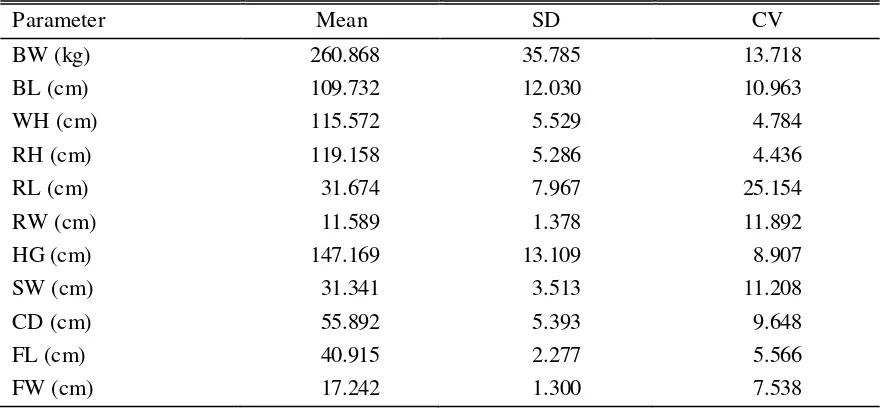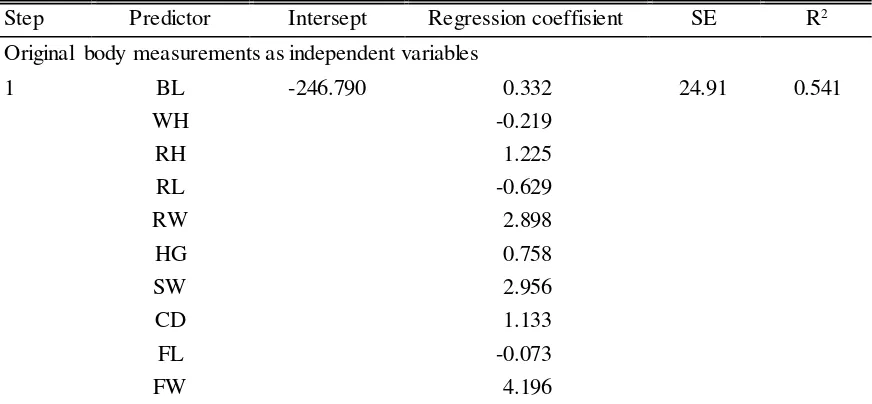Phenotypic Characterization of Jawa Brebes (Jabres) Cattle
Adinata Y, Aryogi, Pamungkas D, Luthfi M, Rasyid A, Krishna NH Indonesian Beef Cattle Research Station
Jl. Pahlawan No. 2, Grati, Pasuruan 67184, East Java, Indonesia yudik [email protected]
ABSTRACT
The aim of this study was to identify the relationship among body measurements in Jabres cattle. A total of 193 cows were used. The parameters recorded were: body length (BL), withers height (WH), rump height (RH), rump length (RL), rump width (RW), heart girth (HG), shoulder width (SW), chest depth (CD), face length (FL), and face width (FW). The results showed that the mean body weight was 260,868 kg while the body measurements were 109.732; 115.572; 119.158; 31.674; 11.589; 147.169; 31.341; 55.892; 40.915; and 17.242 cm for BL, WH, RH, RL, RW, HG, SW, CD, FL, and FW respectively. The coefficients of correlation obtained were: r = 0.269 (BW - BL), r = 0.451 (BW - WH), r = 0.464 (BW - RH), r = 0.123 (BW - RL), r = 0.309 (BW - RW), r = 0.502 (BW - HG), r = 0.519 (BW - SW), r = 0.443 (BW - CD), r = 0.269 (BW - FL), and r = 0.396 (BW - FW) respectively. The components were extracted explaining 51.544% of the total variation. The body measurements could be used as selection criteria for improving body weight of Jabres cattle.
Key Words: Jabres Cattle, Phenotypic Characterization, Body Measurements
INTRODUCTION
Analysis of variance and correlations are used to obtain relationships among different body through the extensive management system and originated from different herds sampled in Brebes Region in Central Java, Indonesia. Efforts were made to restrict sampling to phenotipically pure Jabres cattle respectively by measuring only those that conformed to the classification descriptors of the breed.
Body weight of individual cattle was measured using a digitally weigh scale of 1.000 measurements (cm) were taken using a calibrated wooden calliper. All measurements were car ried out by the same person in order to avoid between individual variations.
Data analysis
The morphological traits were subjected to analysis of means, standard errors and coefficient of variation of body weight and body measurements of the cattle. Pearson correlation coefficients among the body measurements were calculated and the multiple regression procedure was used to obtain models for predicting body weight from body measurements (a) and from factor scores (b).
(a). BW = a + B1X1+ … + BkXk (b). BW = a + B1FS1+ … + BkFSk
Where, BW is the body weight, a is the regression intercept, Bi is the ith partial
regression coefficient of the ith linear body measurement (X
(RW), 147.169 cm (HG), 31.341 cm (SW), 55.892 cm (CD), 40.915 cm (FL), and 17.242 cm (FW) respectively.
The skeletal dimensions of RL, RW, SW, BL, were more variable (coefficient of variation ranged from 10.963 to 25.154%) compared to CD, HG, FW, FL, WH, RH (coefficient of variation ranged from 4.436 to 9.648%).
Table 1. Mean, standard deviation (SD) and coefficient of variation (CV %) for live body weight and body measurements of Jabres cattle
Parameter Mean SD CV breed (Alfranca 2001). Morphology expresses a strong relationship with productive potential, since it contains the structure which supports the biological functionality of the animal (Alpak et al. 2009). The body measurements related to meat value (rump length, chest width, heart girth), these morphostructural changes are related to changes in the productive performance of the animal format; therefore, in the sustained selection process, not only changes in ethnological traits are involved, but also productive traits (Yakubu 2010; Yakubu et al. 2010a; 2010b). Performance especially with regards to meat production can be assessed from body measurements that are less closely associated with bone growth.
Morphostructure provides information susceptible to be used on ethnological characterization of an animal population, and allows a judgment of the productive potential based on the implicit mechanical relationships within the morphologic structure (Yakubu 2010). If the relationship is not considered, it would imply that appropriate productive life adaptation models would not be right (Alpak et al. 2009). It is the diversity in genetic characteristics that enable different animal races to survive in different climatic zones of the world (Yunusa et al. 2013).
measurement will invariably lead to a corresponding increase in the body weight of Jabres relationships between body weight and all the body measurements majority was positive, there are only three were negative (-0.331 for RW-RL, -0.149 for RW-BL, and -0.059 for FL-RW). There are 44 relationships which were highly significant (P<0.01), three relationships which were significant (P<0.05) and eight relationships which were non significant. The highest correlation was obtained between RH-WH while correlation between FW-RW was observed to be the least.
Table 2. Correlation coefficients between live body weight and body measurements of Jabres cattle
*Correlation is significant at the 0.05 level; **Correlation is significant at the 0.01 level
Table 3. Multiple regression of live body weight (kg) on original body measurements of Jabres cattle
Step Predictor Intersept Regression coeffisient SE R2
Original body measurements as independent variables
The results of regression analysis for predicting live body weight from the ten interdependent body measurements of Jabres cattle showed that 54.1% of the variability in live body weight when all the body measurements (BL, WH, RH, RL, RW, HG, SW, CD, FL, and FW) were used in the equation.
CONCLUSION
This study revealed the interdependency of the ten original body measurement characters on each other. the analysis was discovered to be a more appropriate means of predicting live body weight in Jabres cattle than the use of the original interrelated traits measured. The body measurement of face widht, shoulder width, rump width, rum height, chest depth, heart girth, and body length could be used as selection criteria for improving body weight of Jabres cattle.
ACKNOWLEDGEMENT
This research was supported by BCATRES Indonesia. Thank you to all staff at the BCATRES Indonesia which support the facilities for this research.
REFERENCES
Alpak H, Onar V, Mutus R. 2009. The relationship between morphometric and long bone measurements of the Morkaraman sheep.Turk J Vet Anim Sci. 33:199-207.
Alfranca IS. 2001. The breed concept: evolution and reality. Arch Zootec. 50:547-64.
FAO. 2012. Phenotipic characterization of animal genetic resources. Animal production and health guideline no. 11. Rome (Italy): FAO.
Kor A, Baspinar E, Karaca S, Keskin S. 2006. The determination of growth in Akkeci (white goat) female kids by various growth models. Czech J Anim Sci. 51:110-116.
Mutua FK, Dewey CE, Arimi SM, Schelling E, Ogara WO. 2011. Prediction of live body weight using length and girth measurements for pigs in rural Western Kenya. J Swine Health Prod. 19:26-33.
Pundir RK, Pathak BL, Ahalawat SPS. 2007a. Characterization and evaluation of Kankrej breed of cattle in its native tract. Indian J Anim Sci. 77:323-327.
Pundir RK, Singh PK. 2008. Status, characteristics and performance of Red Kandhari cattle breed in its native tract. Indian J Anim Sci. 78:56-61.
Pundir RK, Singh PK, Prakash B, Ahlawat SPS. 2007c. Characterization and evaluation of Kenkatha breed in its native tract. Indian J Anim Sci. 77:177-180.
Pundir RK, Singh PK, Singh KP, Dangi PS. 2011. Factor analysis of biometric traits of Kankrej cows to explain body conformation. Asian Australas J Anim Sci. 24:449-456.
Pundir RK, Singh PK, Uppadhaya SN, Ahlawat SPS. 2007b. Status, characteristics and performance of Red Sindhi cattle. Indian J Anim Sci. 77:755-758.
Salako AE. 2006. Principal component factor analysis of the morpho structure of immature uda sheep. Int J Morphol. 24:571-574.
Yakubu A. 2010. Path coefficient and path analysis of body weight and biometric traits in Yankasa lambs. Slovak J Anim Sci. 43:17-25.
Yakubu A, Salako AE, Imumorin IG. 2010a. Multivariate analysis of spatial patterns of morphological traits in West African Dwarf goats in three agro-ecological zones of Nigeria. J Appl Anim Res. 38:257-60.
Yakubu A, Ogah DM, Idahor KO. 2009. Principal component analysis of the morphstructural indices of White Fulani cattle. Trakia J Sci. 7:67-73.
Yakubu A, Salako AE, Imumorin IG, Ige AO, Akinyemi MO. 2010b. Discriminant analysis of morphometric differentiation in the West African Dwarf and Red Sokoto goats. S Afr J Anim Sci. 40:381-387.

